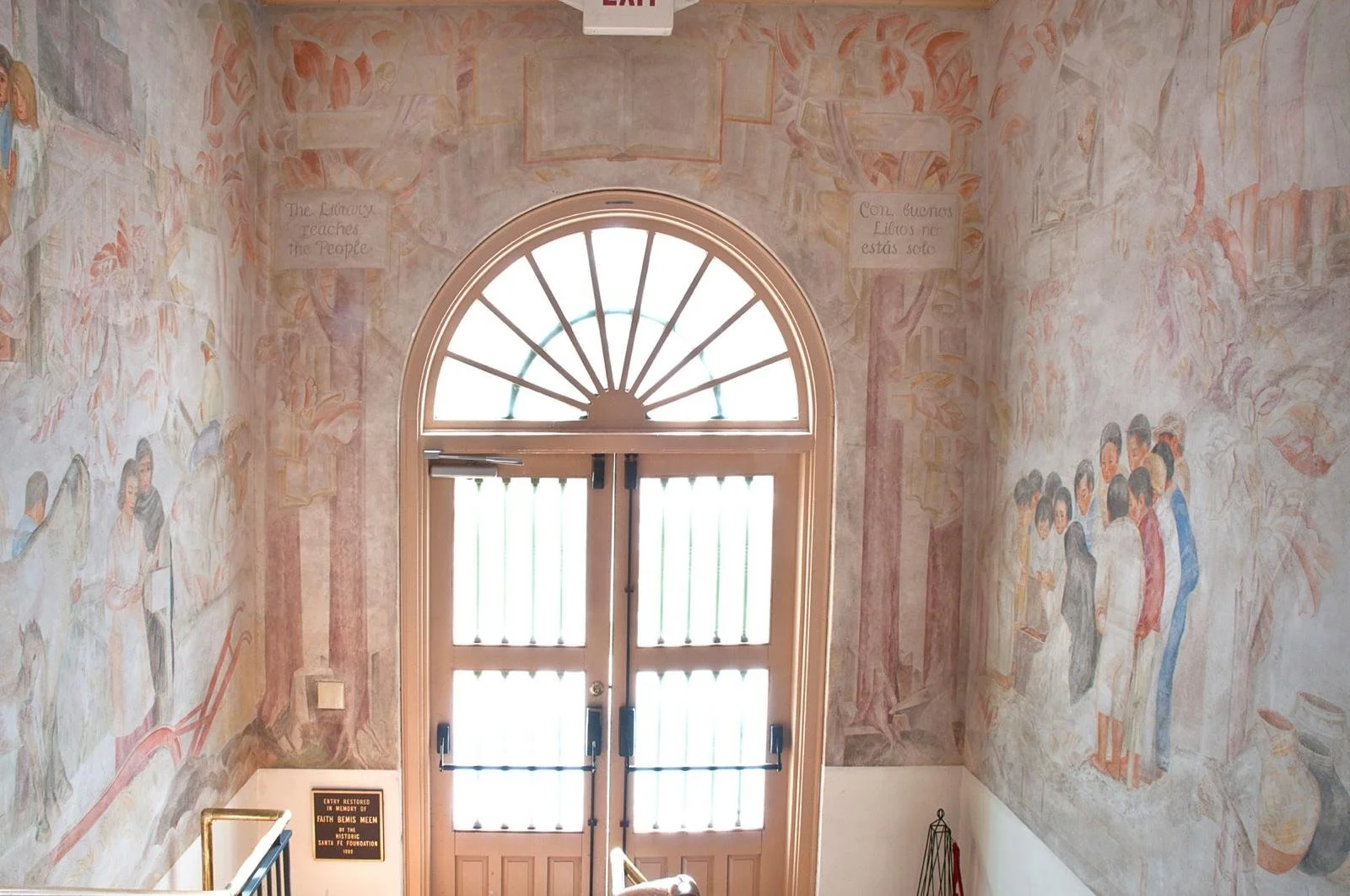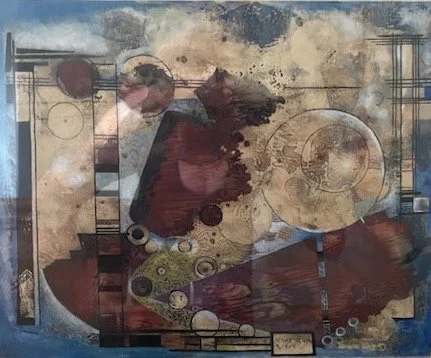Olive Rush’s ART
FROM AGE 17, RUSH HONED HER ART SKILLS AND WORKED AS AN ARTIST
From age 17 to 47, Olive Rush studied art from multiple schools and teachers.¹ During that period, she submitted her easel paintings to competitions. Some won prizes. Her national reputation grew steadily.
Until 1920, Rush worked mostly in the Midwest and East Coast, and supported herself as a fulltime commercial illustrator and working artist. She worked as staff for Harpers Weekly and the New York Tribune and as a free-lance illustrator for books and magazines. On commission, she painted Indiana landscapes, portraits, a reredos (alter panel) in a Delaware Episcopalian church (still in use), and a mural in an Indianapolis grade school (now gone).
Rush became increasingly drawn to modern trends in art. In January 1920, just before she moved west, Rush wrote a two-page statement on her life and art. In it, she said:
“Any art expression must have structure, order, balance and rhythm – a painting no less than a cathedral or a symphony. It must have movement and poise, harmony of color, and contrast of color. These are the essentials. Nature is an essential. She may, or may not, be imitated. Imitation is not a high form of art. I hold aesthetic beauty to be more important to civilization than any other one thing except religion, and that art is not religion’s handmaiden, but her radiant sister.” ²
including Earlham College, the Corcoran School of Art, the Howard Pyle School of Illustration, and the Newlyn School of Art in Cornwall, England. She also studied and sketched in Paris and Senlis, France, and in Antwerp, Belgium, on two European trips with other women artists.
Olive Rush, January 1920. Biographical Narrative Labeled “For Gallery File”, in Smithsonian Arch. of American Artists, Olive Rush Papers, Series 1, Biographical, Box 1, Folder 1, p 4.
“Nixon Rush” 1914 (collection of Jock Lauterer)
“Loreta and Isadore” 1917 (collection of Chris Cradler)
“Woman in Veil and Feathered Hat” 1912 (collection of Ed Roibal)
Cover, Woman’s Home Companion (Olive Rush Studio & Art Center)
Reredos, 1907. St Andrew’s Episcopal Church in Wilmington, Delaware. (Photo by Richard Rush)
IN NEW MEXICO, RUSH CHANGED HER ART
In 1926, Rush wrote to close friend and fellow painter Ethel Brown:
“Let’s be ourselves – forget everything we have ever been taught or heard or seen and work as though this were the first day on earth and our eyes new opened to the world. Let the spirit guide – for all time – for every move of the brush and every thought that we follow out. Then and only then will we make our little contribution to the world.” ¹
During the last half of her life, Rush transformed her painting. Like many American artists of her time, she studied modernism, abstraction, surrealism and Kandinsky on the spiritual in art. She also studied El Greco, Chinese and Japanese brushwork and use of white space, and the art of indigenous Southwest communities and tribes. She combined those influences with her deep technical skills, her love of Southwest landscapes, her Quaker faith, and her increasingly intuitive and spirit-centered approach to painting.
The resulting paintings are beautiful, varied and very difficult to classify. During her lifetime, critics² compared her to French painters Marie Laurencin and Raoul Dufy, and American painters Charles Demuth and Randall Davey. However, most reviewers agreed with museologist Grace Dunham Guest,³ who stated in 1951: “Miss Rush cannot be 'typed.’.” ⁴
1926 letter from Olive Rush to Ethel Brown, in Gilmore 2016 p 104.
See for example Margarite B Williams 1928; Alfred Morang 1941.
See discussion of Grace Dunham Guest’s underrated museum role in Gilmore 2022 https://americanwomenartists.org/neighbors-women-artists-of-canyon-road-santa-fe/
Grace Dunham Guest, 1951. "Olive Rush, Painter." New Mexico Quarterly 21, 4, https://digitalrepository.unm.edu/cgi/viewcontent.cgi?article=3229&context=nmq
“Broken Pitcher” 1932 (collection of Deborah Lewis)
“Apple to the Sea Returning” c 1935 (Roswell NM Museum of Art)
“Clouds and Gazelles” c 1937 (Indianapolis Museum of Art)
“Horses on the Mesa” c 1924 (The Phillips Collection, Washington, DC)
“The Threshing” c 1931 (collection of Brenda Beasley Nickoloff)
DURING THE THIRTIES, RUSH PAINTED MANY FRESCOS AND MURALS
In Santa Fe, Rush became a well-known fresco and mural artist, with commissions in private homes and commercial spaces. Sadly, many of these have been painted over, but inside her home the lively frescos and decorative wall and cabinet paintings can still be seen.
During the 1930’s, Rush painted four murals funded by the Public Works of Art Program and its successor, the Federal Art Project. All of these have been restored and preserved.
A true fresco (painted in wet plaster) in the entry of what was then the public library in Santa Fe, titled “The Library Reaches the People.”
Two true frescos in the Foster Hall Biology Building at New Mexico State University in Las Cruces, titled Cotton Industry and Farming and Natural History of Plant and Animal Life.
An oil on canvas mural titled Osage Treaties in the Pawhuska, Oklahoma Post Office
Another oil on canvas mural titled Antelopes in the Florence, Colorado Post Office
DURING THE WAR YEARS, RUSH AND HER ART BECAME MORE RADICAL
In 1942, critic Alfred Morang wrote: “Olive Rush is a painter possessed of huge technical ability, but she employs it for purely aesthetic purposes. Her landscapes are the shadows of landscapes —dream creations which place her well in the forefront of living American women painters.” ¹
However, during and after World War II, some of Rush’s paintings drew strongly on El Greco’s forms and colors. They portray poignant nightmares rather than dream landscapes — the sadness and horror of war. Some of Rush’s abstract paintings from this period also suggest destruction erupting from mountains (see “Controversy from the Heights” below) — perhaps in response to the atomic bomb emerging from Los Alamos.
In 1947, Rush was awarded an honorary doctorate by Earlham College. Rush had loved her short time at Earlham. However, she wrote in 1920 about her subsequent art education: “Each school vied with the other to stifle every vestige of originality, ingenuity, and imagination that its hapless pupils may have brought into it.” ²
So, in her graduation address, Rush suggested Earlham emulate the radical, John Dewey-based art education experiments taking place at Black Mountain College in North Carolina. “I am told that individuals in that school create courses and classes through felt need and interest, and that loving the work, the quality of study rather than the number of courses tells in the development of taste and imagination.” ³
Alfred Morang 1942. in Smithsonian Arch. of American Artists, Olive Rush Papers, Series 6, Clippings, Box 5, Folder 12, 1940-49, p 20.
Olive Rush, January 1920. Biographical Narrative Labeled “For Gallery File”, in Smithsonian Arch. of American Artists, Olive Rush Papers, Series 1, Biographical, Box 1, Folder 1, p 4.
Olive Rush, June 13, 1947. Address by Olive Rush to Earlham College, in Smithsonian Arch. of American Artists, Olive Rush Papers, Series 3, Writings, Talks and Lectures, Box 2, Folder 31, p 46.
Olive Rush in 1947 at Earlham College, when she received an honorary doctorate from Earlham College, Indiana. Photograph courtesy of Palace of the Governors Photo Archives (NMHM/DCA) 019272.
“Mourning Women” c 1940-45 (Collection of Gilmore-Puckett)
“After War: Empty Food Pots” c 1946-1950 (Olive Rush Studio & Art Center)
“The Dove” c 1949 (Collection of Richard Rush)
"Controversy in the Heights" c 1948 - 52 (Olive Rush Studio & Art Center)
"After War - Frustration" no date. (New Mexico Museum of Art, gift of Amelia Elizabeth White, 1961. 312.23P)
DURING THE FIFTIES, RUSH’S PAINTINGS DEEPENED
In 1957, when Rush was 84, she had a solo show at the Museum of New Mexico. Her Artist’s Statement in the exhibit’s catalogue said:
“After all this study from nature, little reliance on sketches or on natural objects seems necessary. My painting is now done intuitively and thru sympathy with the spirit of nature, its miracle and mystery. I try to reveal through form, line, color, what I see and feel. It is a searching for relations and harmonies to bring all together into one whole, an overall pattern, what the Chinese call ‘Rhythmic vitality’. I have made many experiments, made many failures, but always in the search to find myself.
I acknowledge the influence of the early Chinese, the Japanese, and El Greco. They are my Masters. They worked by the spirit, from and for the spirit. Van Gogh and Matisse were followers of the Japanese. I admire their works, am proud to belong to their line… I am a follower of George Fox, whose reliance upon the inner light was complete.” ¹
Rush did not retire that year. She continued to paint until 1962 (age 89), when age, memory loss, illness and stroke sidelined her brush and ability to express her inward vision.
Pablita Velarde, the well-known painter from Kha'p'oe Ówîngeh, worked with Rush on the Maisel murals in 1939. She said about Rush in 1988, 22 years after her death: “All of her work had that soft tone with hidden messages. Hers was a great spirit.” ²
Olive Rush Catalog 1957. Museum of New Mexico, in Smithsonian Arch. of American Artists, Olive Rush Papers, Series 6, Printed Materials, Exhibition Catalogs, Box 5, Folder 2, 1957, pp 3 to 6.
Bart Ripp 1988. “11 Indian Painters Created a Treasure at Maisel’s” Albuquerque Tribune, Feb 1, 1988, Section B, p 2.
“Three Birds” 1954 (Olive Rush Studio & Art Center)
“Abstract Composition” 1950 (collection of Brenda Beasley Nickoloff)
“Reverie” (collection of Bettina Raphael)
“White City” c 1950 (collection of Priscilla Woodman)
"Into the Street of the Sky, Light Walks" 1961. (Title comes from a 1922 poem by e. e. cummings. New Mexico Museum of Art 126.23P)

























